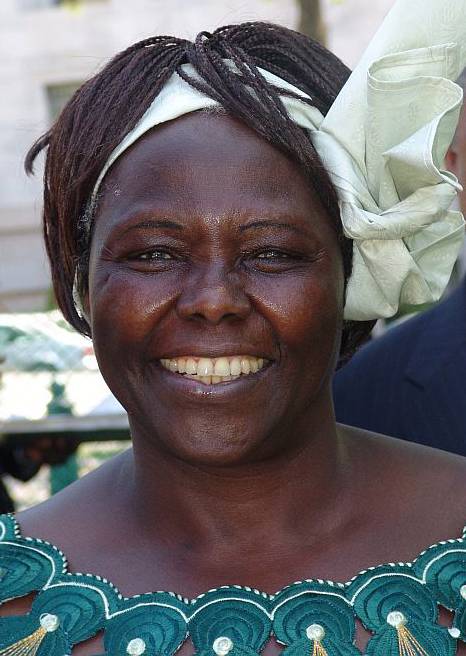
FAQ About Wangari Maathai

Who is Wangari Maathai?
Wangari Maathai was a renowned environmentalist and political activist from Kenya. She was the first African woman to win the Nobel Peace Prize for her contributions to sustainable development, democracy, and peace. Maathai is best known for founding the Green Belt Movement, which focused on environmental conservation and women's rights.

What did Wangari Maathai achieve with the Green Belt Movement?
The Green Belt Movement, founded by Wangari Maathai in 1977, aimed to combat environmental degradation through tree planting. The movement not only helped in conserving the environment but also empowered women by providing them with job opportunities, enhancing their income, and increasing their capacity to improve their lives. It is one of the leading conservation movements in Africa.

Why did Wangari Maathai receive the Nobel Peace Prize?
Wangari Maathai was awarded the Nobel Peace Prize in 2004 for her outstanding efforts in sustainable development, democracy, and peace. Her work with the Green Belt Movement was recognized for creating a link between the environment, sustainable development, and peace, showing how these can contribute to better living conditions, especially for women in Africa.

How did Wangari Maathai contribute to women's rights?
Wangari Maathai was a strong advocate for women's rights, particularly through her work with the Green Belt Movement. She empowered women by involving them in environmental conservation activities, such as tree planting, which offered them income generating opportunities and increased their social and economic standing within their communities.

What is the significance of the Green Belt Movement?
The Green Belt Movement is significant because it has planted over 51 million trees in Kenya, addressing issues of deforestation and environmental degradation. Additionally, it has greatly empowered women and communities through education and involvement in environmental conservation. This has contributed to improved livelihoods and has been a model for community-led environmental activism worldwide.

Where was Wangari Maathai educated?
Wangari Maathai received her education in the United States and Kenya. She studied at Mount St. Scholastica College (now Benedictine College) in Kansas, where she earned her bachelor's degree in Biology. She then obtained a master's degree in Biological Sciences from the University of Pittsburgh. Maathai later returned to Kenya and became the first East African woman to earn a Ph.D. from the University of Nairobi.

What did Wangari Maathai write about?
Wangari Maathai authored several books focusing on environmental conservation, women's empowerment, and socio-political issues. Some of her notable works include 'Unbowed: A Memoir,' which details her life and work, 'The Green Belt Movement,' and 'Replenishing the Earth.' These books provide insights into her activism and the philosophy behind her environmental and social justice efforts.

How did Wangari Maathai's work impact global environmental policies?
Wangari Maathai's advocacy for sustainable environmental practices and her emphasis on grassroots movements influenced global perspectives on environmental policies. Her work highlighted the important role of women and communities in conservation efforts, contributing to international dialogues on sustainable development and leading to more inclusive policies that recognize the interconnectedness of environment, economy, and peace.

What challenges did Wangari Maathai face in her activism?
Wangari Maathai faced numerous challenges during her activism, including political opposition, gender discrimination, and imprisonment. Her efforts to promote democracy and environmental conservation often put her in conflict with Kenyan authorities, leading to her arrest and physical attacks. Despite these challenges, her resilience heightened awareness and inspired global support for her causes.

What awards did Wangari Maathai receive besides the Nobel Peace Prize?
In addition to the Nobel Peace Prize, Wangari Maathai received numerous other awards and honors recognizing her work in environmental and social justice. These include the Goldman Environmental Prize, the Right Livelihood Award, and the UNEP Global 500 Roll of Honor Award, among others. Her accolades celebrate her pioneering efforts and impactful leadership.

What is Wangari Maathai's legacy?
Wangari Maathai's legacy is profound and multifaceted. She is remembered for her tireless efforts to improve environmental conservation, promote women's rights, and advocate for democratic governance. The Green Belt Movement continues to thrive, inspiring global efforts in environmental activism. Her life serves as a testament to the power of grassroots movements and the critical connection between the health of the planet and the prosperity of its people.

How did Wangari Maathai influence women in Africa?
Wangari Maathai's work provided a powerful model for women in Africa by connecting environmental conservation with women's empowerment. Her leadership in the Green Belt Movement demonstrated that women could be central to addressing environmental challenges while simultaneously improving their socio-economic status. She inspired many women to take active roles in their communities and pursue leadership positions.

What role did Wangari Maathai play in Kenyan politics?
Wangari Maathai played a significant role in Kenyan politics as an advocate for democracy and social justice. She was elected as a Member of Parliament in 2002 and served as Assistant Minister for Environment and Natural Resources from 2003 to 2005. Her political career was marked by her continued fight for environmental conservation and the rights of women and marginalized communities in Kenya.

How did the international community react to Wangari Maathai's initiatives?
The international community widely recognized and supported Wangari Maathai's initiatives, particularly her integration of environmental conservation with socio-economic development. Many organizations and governments lauded her efforts by granting awards and providing platforms to further her mission. Her strategies are referenced in various international environmental policies and serve as a model for sustainable development.

What inspired Wangari Maathai to start the Green Belt Movement?
Wangari Maathai was inspired to start the Green Belt Movement after observing the negative impacts of deforestation, such as soil erosion and decreased agricultural productivity, which disproportionately affected Kenyan women. She realized that tree planting could address these environmental challenges while simultaneously empowering women through participation in conservation work.

What educational qualifications did Wangari Maathai hold?
Wangari Maathai was highly educated, holding a Bachelor of Science degree in Biology from Mount St. Scholastica College, a Master of Science in Biological Sciences from the University of Pittsburgh, and a Ph.D. from the University of Nairobi, where she became the first woman in East Africa to earn a doctorate in veterinary anatomy.

How has Wangari Maathai's work influenced environmental activism today?
Wangari Maathai's work has had a lasting influence on environmental activism by highlighting the importance of grassroots involvement and the active participation of women. Her approach to link environmental conservation with socio-economic issues has been adopted by many organizations globally, inspiring newer generations to advocate for sustainable development and community-based solutions to ecological challenges.

Did Wangari Maathai face any political challenges during her career?
Yes, Wangari Maathai faced significant political challenges during her career. Her activism led to frequent clashes with the Kenyan government, resulting in her arrest on multiple occasions. Despite these challenges, she remained steadfast in her commitment to environmental and social causes, and her efforts contributed to greater political awareness and reforms in Kenya.

How did Wangari Maathai use education as a tool for change?
Wangari Maathai used education as a key tool for change by raising awareness about environmental conservation and women's rights. Through the Green Belt Movement, she provided training and education to communities about sustainable environmental practices. Her educational background also helped in advocating and articulating her vision on national and international platforms, effectively bridging the gap between science and activism.

How does the Green Belt Movement continue Wangari Maathai's vision?
The Green Belt Movement continues Wangari Maathai's vision by promoting environmental conservation, planting trees to combat deforestation, and empowering communities through sustainable development practices. The movement engages with new generations to educate them on ecological issues and inspire continued activism in environmental and social justice.
